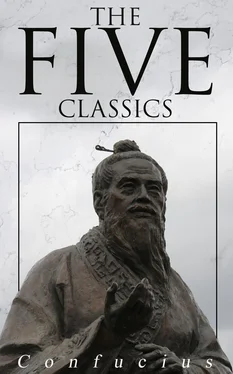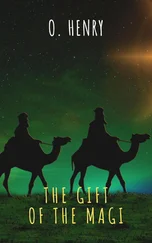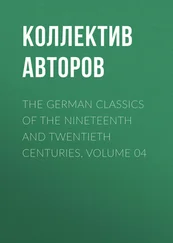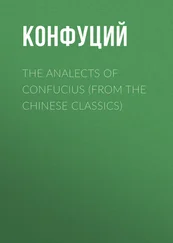The hexagram Sze is composed of the two trigrams Khan (  ) and Khwăn (
) and Khwăn (  ), exhibiting waters collected on the earth; and in other symbolisms besides that of the Yî, waters indicate assembled multitudes of men. The waters on which the mystical Babylon sits in the Apocalypse are explained as 'peoples and multitudes and nations and tongues.' I do not positively affirm that it was by this interpretation of the trigrams that king Wăn saw in
), exhibiting waters collected on the earth; and in other symbolisms besides that of the Yî, waters indicate assembled multitudes of men. The waters on which the mystical Babylon sits in the Apocalypse are explained as 'peoples and multitudes and nations and tongues.' I do not positively affirm that it was by this interpretation of the trigrams that king Wăn saw in  the feudal hosts of his country collected, for neither from him nor his son do we learn, by their direct affirmation, that they had any acquaintance with, the trigrams of Fû-hsî. The name which he gave the figure shows, however, that he saw in it the feudal hosts in the field. How shall their expedition be conducted that it may come to a successful issue?
the feudal hosts of his country collected, for neither from him nor his son do we learn, by their direct affirmation, that they had any acquaintance with, the trigrams of Fû-hsî. The name which he gave the figure shows, however, that he saw in it the feudal hosts in the field. How shall their expedition be conducted that it may come to a successful issue?
Looking again at the figure, we see that it is made up of five divided lines, and of one undivided. The undivided line occupies the central place in the lower trigram,--the most important place, next to the fifth, in the whole hexagram. It will represent, in the language of the commentators, 'the lord of the whole figure;' and the parties represented by the other lines may be expected to be of one mind with him or obedient to him. He must be the leader of the hosts. If he were on high, in the fifth place, he would be the sovereign of the kingdom. This is what king Wăn says:--
'Sze indicates how (in the case which it supposes), with firmness and correctness, and (a leader of) age and experience, there will be good fortune and no error.'
This is a good auspice. Let us see how the duke of K âu expands it.
He says:--
'The first line, divided, shows the host going forth according to the rules (for such a movement). If those (rules) be not good, there will be evil.'
We are not told what the rules for a military expedition were. Some commentators understand them of the reasons justifying the movement,--that it should be to repress and punish disorder and rebellion. Others, with more likelihood, take them to be the discipline or rules laid down to be observed by the troops. The line is divided, a weak line in a strong place, 'not correct:' this justifies the caution given in the duke's second sentence.
The Text goes on:--
'The second line, undivided, shows (the leader) in the midst of the hosts. There will be good fortune and no error. The king has thrice conveyed to him his charge.'
This does not need any amplification. The duke saw in the strong line the symbol of the leader, who enjoyed the full confidence of his sovereign, and whose authority admitted of no opposition.
On the third line it is said:--
'The third line, divided, shows how the hosts may possibly have many commanders:--(in such a case) there will be evil.'
The third place is odd, and should be occupied by a strong line, instead of which we have a weak line in it. But it is at the top of the lower trigram, and its subject should be in office or activity. There is suggested the idea that its subject has vaulted over the second line, and wishes to share in the command and honour of him who has been appointed sole commander-in-chief. The lesson in the previous line is made of none effect. We have a divided authority in the expedition. The result can only be evil.
On the fourth line the duke wrote:--
'The fourth line, divided, shows the hosts in retreat: there is no error.'
The line is also weak, and victory cannot be expected but in the fourth place a weak line is in its correct position, and its subject will do what is right in his circumstances. He will retreat, and a retreat is for him the part of wisdom. When safely affected, where advance would be disastrous, a retreat is as glorious as victory.
Under the fifth line we read:--
'The fifth line, divided, shows birds in the fields which it is advantageous to seize (and destroy). There will be no error. If the oldest son lead the host, and younger men be (also) in command, however firm and correct he may be, there will be evil.'
We have an intimation in this passage that only defensive war, or war waged by the rightful authority to put down rebellion and lawlessness, is right. The 'birds in the fields' are emblematic of plunderers and invaders, whom it will be well to destroy. The fifth line symbolises the chief authority, but here he is weak or humble, and has given all power and authority to execute judgment into the hands of the commander-in-chief, who is the oldest son; and in the subject of line 3 we have an example of the younger men who would cause evil if allowed to share his power.
Finally, on the sixth line the duke wrote:--
'The topmost line, divided, shows the great ruler delivering his charges (to the men who have distinguished themselves), appointing some to be rulers of states, and others to be chiefs of clans. But small men should not be employed (in such positions).'
The action of the hexagram has been gone through. The expedition has been conducted to a successful end. The enemy has been subdued. His territories are at the disposal of the conqueror. The commander-in-chief has done his part well. His sovereign, 'the great ruler,' comes upon the scene, and rewards the officers who have been conspicuous by their bravery and skill, conferring on them rank and lands. But he is warned to have respect in doing so to their moral character. Small men, of ordinary or less than ordinary character, may be rewarded with riches and certain honours; but land and the welfare of its population should not be given into the hands of any who are not equal to the responsibility of such a trust.
The above is a specimen of what I have called the essays that make up the Yî of K âu. So would king Wăn and his son have had all military expeditions conducted in their country 3000 years ago. It seems to me that the principles which they lay down might find a suitable application in the modern warfare of our civilised and Christian Europe. The inculcation of such lessons cannot have been without good effect in China during the long course of its history.
Sze is a fair specimen of its class. From the other 63 hexagrams lessons are deduced, for the most part equally good and striking. But why, it may be asked, why should they be conveyed to us by such an array of lineal figures, and in such a farrago of emblematic representations? It is not for the foreigner to insist on such a question. The Chinese have not valued them the less because of the antiquated dress in which their lessons are arrayed. Hundreds of their commentators have evolved and developed their meaning with a minuteness of detail and felicity of illustration that leave nothing to be desired. It is for foreign students of Chinese to gird up their loins for the mastery of the book instead of talking about it as mysterious and all but inexplicable.
Granting, however, that the subject-matter of the Yî is what has been described, very valuable for its practical wisdom, but not drawn up from an abysmal deep of philosophical speculation, it may still be urged, 'But in all this we find nothing to justify the name of the book as Yî King, the "Classic of Changes." Is there not something more, higher or deeper, in the Appendixes that have been ascribed to Confucius, whose authority is certainly not inferior to that of king Wăn, or the duke of K âu?' To reply fully to this question will require another chapter.
Читать дальше

 ) and Khwăn (
) and Khwăn (  ), exhibiting waters collected on the earth; and in other symbolisms besides that of the Yî, waters indicate assembled multitudes of men. The waters on which the mystical Babylon sits in the Apocalypse are explained as 'peoples and multitudes and nations and tongues.' I do not positively affirm that it was by this interpretation of the trigrams that king Wăn saw in
), exhibiting waters collected on the earth; and in other symbolisms besides that of the Yî, waters indicate assembled multitudes of men. The waters on which the mystical Babylon sits in the Apocalypse are explained as 'peoples and multitudes and nations and tongues.' I do not positively affirm that it was by this interpretation of the trigrams that king Wăn saw in  the feudal hosts of his country collected, for neither from him nor his son do we learn, by their direct affirmation, that they had any acquaintance with, the trigrams of Fû-hsî. The name which he gave the figure shows, however, that he saw in it the feudal hosts in the field. How shall their expedition be conducted that it may come to a successful issue?
the feudal hosts of his country collected, for neither from him nor his son do we learn, by their direct affirmation, that they had any acquaintance with, the trigrams of Fû-hsî. The name which he gave the figure shows, however, that he saw in it the feudal hosts in the field. How shall their expedition be conducted that it may come to a successful issue?










